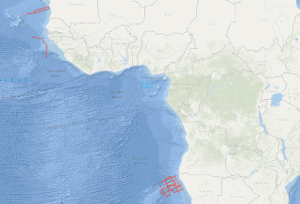During the second leg of cruise BGR78 from 22th of February to 29th of March 1978 with R/V EXPLORA the following measurements have been carried out as presite- and postsite surveys of DSDP sites: (1) in the region of the eastern Walvis Ridge 4,350 km multichannel seismic reflection profiles, 4,540 km magnetic measurements, 5,000 km gravimetric measurements and sonobuoy refraction measurements on 11 stations (2) on the Guinea Plateau 740 km multichannel seismic reflection profiles in parallel with gravimetric and magnetic measurements (3) between Cape Verde islands and Mauretania 980 km multichannel seismic reflection profiles in parallel with magnetic measurements, 1,480 km gravimetric measurements and sonobuoy refraction measurements on 2 stations. The geophysical measurements show that the structure of the Walvis Ridge is determined by two main tectonic directions (WSW-ENE and SSW-NNE). Presumably the genesis of the fracture zone in the Walvis Ridge area can be traced back to the sea-floor spreading with overprinting effects due to an inhomogeneity in the mantle ("hot spot"). Both DSDP drilling projects in this part of the Walvis Ridge led to a fragmentary knowledge because site 362 got stuck at a depth of 1.100 m in the Oligocene. BGR's measurements indicate a gap of at least 1.000 m of sediments, especially from the cretaceous period, down to the (acoustic) basement. Site 363 at a submarine high has gaps in the depositional sequence and stops at a depth of 700 m shortly above the basement. So for a better understanding of the geologic development of the Walvis Ridge, further DSDP drillings with a recovery of the complete sedimentary sequence and the following basement cores are necessary. Therefore BGR's measurements of this cruise propose new DSDP sites. In der Zeit vom 22. Februar bis zum 29. März 1978 sind auf dem zweiten Abschnitt der Fahrt BGR78 mit R/V EXPLORA folgende Messungen als presite- und postsite-surveys von DSDP-Bohrungen ausgeführt worden: (1) im Bereich des östlichen Walvis-Ridge 4.350 Profilkilometer Mehrspurseismik, 4.540 Profilkilometer Magnetik, 5.000 Profilkilometer Gravimetrie sowie refraktionsseismische Messungen auf 11 Stationen mit Sonobojen (2) auf dem Guinea-Plateau 740 km Mehrspurseismik, Magnetik und Gravimetrie sowie 1 Sonoboje, (3) zwischen den Kapverden und Mauretanien 980 km Mehrspurseismik und Magnetik, 1.480 km Gravimetrie sowie 2 Sonobojen. Nach den Ergebnissen der Erstauswertung an Bord von R/V EXPLORA kann der Walvis-Ridge als eine Struktur angesehen werden, die in ihrer Ausbildung von zwei tektonischen Richtungen (WSW-ENE und SSW-NNE) bestimmt wird. Das deutet auf eine Entstehung als Bruchzone nach der Theorie des sea-floor-spreading hin, die von einer Inhomogenität im Erdmantel ("hot spot") überprägt worden ist. Die beiden DSDP-Bohrungen in diesem Teil des Walvis-Ridge sind unvollständig. Site 362 in einem Sedimentbecken ist mit 1100 m Endteufe im Oligozän steckengeblieben. Nach den BGR-Messungen fehlen noch mindestens 1000 m Sedimente (darunter solche aus der Kreide) bis zum (akustischen) Basement. Site 363 an einer submarinen Erhöhung weist Schichtlücken im Sedimentprofil auf und geht mit 700 m Endteufe bis dicht an das Basement. Zur Klärung der Entstehungsgeschichte des Walvis-Ridge werden aufgrund der BGR-Messungen Lokationen für weitere DSDP-Bohrungen zur Gewinnung einer Basementfolge und zur Gewinnung eines vollständigen Sedimentprofils vorgeschlagen.





